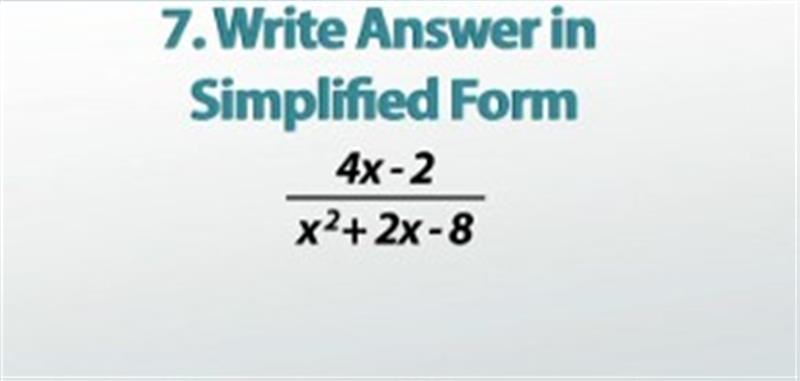Example #2
((2x) / (x^2 - 16)) - (1 / (x + 4))
x^2 - 16 factors into (x - 4)(x + 4). So let's put that into the expression.
((2x) / ((x - 4)(x + 4))) - (1 /(x + 4))
Our next step is to write down all of our denominators.
In the first term, we have (x + 4)(x - 4), so we write those down.
We continue to the next term and look at the denominator. We never duplicate denominators from term to term. Since we already have (x + 4) written as part of our denominator, we don't need to duplicate it. So it turns out our common denominator will be (x + 4)(x - 4).
Now we need to create our common denominator. Let's look at our first term ((2x) / (x + 4)(x - 4)). We already have our common denominator here, so we're going to move to the next term: (1 / (x + 4)).
Here, we need to multiply (x - 4) to make our common denominator. But if we multiply (x - 4) on the bottom, we need to multiply by (x - 4) on the top. For right now, we are going to write it and not multiply yet. So we have ((2x) / (x + 4)(x - 4)) - (1(x - 4) / (x + 4)(x - 4)).
After collecting like terms, the resulting expression can be factored
Let's write the numerator all over the denominator.
((2x)-1(x-4))/((x+ 4)(x - 4))
Simplify the numerator (or top) and rewrite it over the denominator.
Distribute the -1 into (x - 4) = -1x + 4.
Collecting like terms, 2x - 1x= x.
So now our expression looks like:
(x + 4) / (x+ 4)(x- 4)
We can slash, or cancel, (x+ 4) over (x+ 4).
This gives us 1/(x - 4) as our final answer.
Example #3
((5x^2 - 3) / (x^2 + 6x + 8)) - 4
The first step is to factor.
x^2 + 6x + 8 = (x + 4)(x + 2)
Our next step is to write down all of our denominators.
In our first term, we have (x + 4)(x + 2), so we write it down.
The denominator for the next term is 1.
Therefore, our common denominator will be (x + 4)(x + 2).
Now we need to create our common denominator. Let's look at our first term (5x^2 - 3)/((x + 4)(x + 2)).
We already have our common denominator here, so we're going to move to the next term, 4.
Here, we only have a 1 in the denominator, so we need to multiply by (x + 4)(x + 2) over (x+4)(x+2).
This is what our new expression is going to look like:
((5x^2 - 3) / (x + 4)(x + 2)) - ((4 (x + 4)(x + 2)) / ((x + 4)(x + 2))) .
kkk

The final step after using FOIL to simplify the expression
Let's write the whole numerator (top) over the denominator (bottom).
((5x^2 - 3 - 4(x + 4)(x + 2))) / ((x + 4)(x + 2))
We can now simplify the top, or numerator.
(x+4)(x+2) = x^2 +6x +8
Multiply -4( x^2 +6x +8) and we have -4x^2 - 24x - 32.
Let's continue with the numerator and collect like terms, so our expression looks like:
(x^2 - 24x - 35) / ((x + 4)(x + 2))
The numerator does not factor without using the quadratic formula, so this is almost our answer, except we need to FOIL the bottom, or denominator. Here is our final answer:
(x^2 - 24x - 35) / (x^2 + 6x + 8)